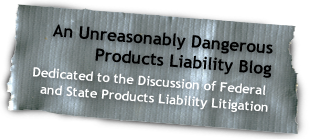
Today, Abnormal Use continues its series, “Abnormal Interviews,” in which this site will conduct interviews with law professors, practitioners, and makers of legal-themed pop culture. As you might recall, we here at Abnormal Use have been fortunate to interview individuals in the entertainment industry who have participated in legally themed television shows and films. We have interviewed Phil Morris, the actor who played the flamboyant attorney, Jackie Chiles, in “Seinfeld,” as well as the late, great James Rebhorn, who played, among many other roles, the FBI expert witness in My Cousin Vinny. We recently had the opportunity to speak with actress Roma Maffia, who has appeared in a spate of blockbuster films and television series, including Disclosure, Double Jeopardy, “Nip/Tuck,” “Boston Legal,” “Law & Order,” “Profiler,” and Nick of Time, to name just a few. She has played a lawyer or judge in many of these roles. A fun historical note: Today is the fifteenth anniversary of the release of Double Jeopardy, a film in which she played a jailhouse lawyer dispensing advice to Ashley Judd’s character. (You remember the crazy premise: If she has been wrongfully convicted of a murder that never occurred, then double jeopardy would prevent her prosecution for later murdering the purported original victim.). Additionally, this December 4 will be the twentieth anniversary of the release of Disclosure, the Michael Crichton sexual harassment thriller in which she played a lawyer advising the Michael Douglas character in his dispute with his employer. The interview is as follows:
ON THE ANNIVERSARIES OF DISCLOSURE AND DOUBLE JEOPARDY
Kyle White: Were you aware that the anniversaries were coming up for those movies?
Roma Maffia: Well, I wasn’t. It’s pretty shocking. No, I wasn’t.

LEGAL EXPERIENCE PRIOR TO FIRST LEGAL ROLE IN DISCLOSURE
RM: None! . . . [I]n New York, I didn’t do much television or film, but I acted the role of the character who would be arrested by the police, such as a prostitute or a drug addict, or some kind of felon as opposed to a lawyer.
KW: Interesting.
RM: It’s after I did Disclosure . . . . Well, you know, you get type cast. So, because it was Disclosure, all of a sudden I became the lawyer. . . . . I did do research on the movie, but before the movie? No, I had nothing to do with law.
KW: So, you are saying that Disclosure was the first time you had been involved with acting as a lawyer or a judge?
RM: First time, absolutely, first time!
ASSISTANCE FROM THE LEGAL COMMUNITY IN PREPARING FOR ROLES
RM: On those roles as lawyers, any role, pretty much, I’m sure myself, like a lot of actors, do a lot of research. So, I’ve been very fortunate to have really great people. Also, when I did Disclosure, it was fantastic because it was the big case of the football player that was televised.
KW: The O.J. Simpson trial?
RM: Yes. So, I got to watch all day of the trial. So I got to watch Marcia [Clark], the female lawyer, sort of be my role model for Disclosure. For Double Jeopardy, I also had legal help and advice, [and I] went to a prison in L.A. So, I’ve been very lucky to have lawyers help me or forensic pathologists. Everyone in a specific field is very, very helpful. So, all the lawyers that have helped me have been very generous with their time and have taught me quite a lot.
KW: That’s great. Is there any lawyer in particular . . . who has helped you in preparing for your roles, or have you just sort of talked with a different lawyer each time?
RM: I’ve talked with different lawyers each time.

KW: That is interesting to know that you dealt directly with the legal community.
RM: Very much so, yes. I actually thought with the amount of lawyers I played, I was going to get some kind of degree or something. Is that possible?
KW: [Laughter] You should, you definitely should!
RM: I should!
IMPORTANT SOCIAL CONTEXT OF DISCLOSURE
RM: Well, I had done The Paper with Ron Howard before, where I played a reporter. But it was my first really large role, and I loved the subject matter because, at the time, it was a big hoo ha that sexual harassment had not been addressed in film. And then that it should be addressed with the man that is a victim caused an interesting stir. But, just that the topic was so – everyone on the set was so impassioned by this topic. It was also a time, when, you know, computers and how they were used in offices, and the mixture of a computer and send[ing] messages in code. It was very exciting. The whole concept of the sexual harassment; and, I think some people were like, “Oh I didn’t even realize man could be sexually harassed, even if he is the boss.” I think it addressed lots of elements that were surprising . . . .
SERVICE ON A REAL-LIFE JURY
RM: . . . I was on a jury . . . [I]t was the first time I really understood, or got an inkling, like I said, about how specific the law is to . . . that it was frustrating.
KW: That’s interesting. I’m curious, on what kind of jury did you serve?
RM: It was a mother who had killed her four year old daughter.
KW: Oh, wow, that’s a tough one to sit through.
RM: Oh, my god, I begged. You know, it was funny because the judge, it was in Los Angeles, and the judge recognized me from wherever. He sort of made fun, like is this the way you imagined it when you do your film or television? I was like, “No, no, no, it’s not!” I didn’t want to do that case, but just in that case, and I guess because it was real life, so the stakes were very different. How we couldn’t get what we wanted for the punishment for the mother to be. So, because of what seemed like minutia, but anyway, I know, it’s no. But that, I found very difficult and frustrating.
KW: . . . [W]hen did that happen in your professional career?
RM: It happened about seven years ago. When I was there, Pat Boone was also serving on a jury.
KW: Really?
RM: Yes, He was in court outside having lunch at the public lunch table. Which was pretty funny, I thought.
ADVICE TO LITIGATORS – “LESS IS MORE”
KW: Any legal roles you have played since your jury duty experience that the experience on the jury has shaped? If so, how?
RM: [T]he one thing is less is more. That’s the one thing I take away from my jury experience and also talking to lawyers about what a witness is to or not to say.
KW: . . . What exactly do you mean there? That sounds like good advice for practicing attorneys.
RM: I just meant that it’s, instead of going on, just answer the question, without leaving room for any interpretation of the answer. No interpretation, just the answer. Simple, “Yes,” “No.” You know, I think it’s human nature to go, “No, but I saw this,” and not realizing you’ve opened up another topic that you weren’t aware that you did. Now we go down another rabbit hole. Does that make sense?
KW: Exactly. And you’ve touched on probably one of our frustrations encountered in the practice of law – getting witnesses to understand that; to simply answer the question.
RM: Yes, I think it’s a thing you think you’re talking to your parents or the principal and the more you talk, the more they are going to understand your dilemma without understanding the more you talk the more you are setting up a dilemma.
HER FAVORITE ROLE
KW: . . . You’ve played, some major characters in some huge television shows and other movies. You’ve been in “Boston Legal.” You’ve been in “Law & Order.” You’ve been in “The Sopranos.” You’ve been in “ER” and recently. You played in the hit series “Nip/Tuck” and played a huge role in that. Which one of your roles that you played in the past has been your favorite role and why?
RM: That’s such an interesting question. I think because. . . Each one has their own uniqueness that I will remember. But definitely, Disclosure, because it was an eye-opener into a whole other world of film. I learned a lot about film, which I had not known or been introduced to. But Liz on “Nip/Tuck” was being an anesthesiologist and learning all those things, a little like people generous to teach me was. That’s what it is. It’s just so fascinating to be able to enter into all these worlds and just learn just a little bit of something. So I have to say, Liz on “Nip/Tuck.” I’d have to say on “Profiler,” my character was a forensic pathologist. And, I loved that. It was fascinating; pathology and crime, and honoring the dead. So many of them. Yet, there are roles that I do that have been plays that are comedies that I enjoy. So, it’s hard to pinpoint because I could go through my resume and go “Oh, no, I love that one, too.” I’ve just forgotten what I did. So, for now, those ones pop out. Oh, and I loved the character in Nick of Time. She was fantastic. So, yes. It’s hard to say.





















